“If the grocery shelves are empty, you are only nine meals away from anarchy” – Mike (Doomsday Preppers)
All the foods listed below should be stored in similar conditions. The four main enemies of (preserving) any foodstuff are:
Oxygen – causes food to oxidize
Sunlight – speeds up the spoiling process and can produce chemical reactions;
Temperature – speeds up the spoiling process;
Moisture – allows bacteria to grow
So remove as much oxygen as possible when storing a food item in an impermeable container. Store in a cool dark dry place.
1. Hardtack
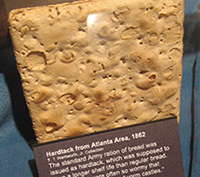
Hardtacks contains Sodium, Potassium, Protein, Vitamin B6, Carbohydrates, Zinc, Calcium … I’m not going to write down the whole list because it contains a little bit of any Vitamins and Minerals.
Records show that ancient Egyptian and Roman sailors had their own version of hard tack.
But the Civil War is what most people remember it from, and it was that war that proved the extreme longevity of this hardy biscuit. Much of the initial supplies fed to Union and Confederate troops were leftovers from the Mexican-American War, and so much hard tack was made during the Civil War, that it wouldn’t be completely eaten until the Spanish American War; a whole 50 years later.
2. Dry Milk in nitrogen packed cans
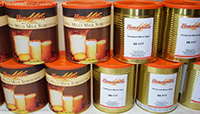 Powdered milk is a good source of Calcium, Vitamin D, Protein and also contains Vitamin A, Vitamin B, Vitamin C, Vitamin E and Potassium.
Powdered milk is a good source of Calcium, Vitamin D, Protein and also contains Vitamin A, Vitamin B, Vitamin C, Vitamin E and Potassium.
If the dry milk purchased was not packaged for long term storage then it should be repackaged right away.
Powdered milk canned with nitrogen or carbon dioxide to replace air (which contains oxygen) will keep longer (decades) than powdered milk exposed to air. Vacuum canning or oxygen absorbers will also decrease the available oxygen.
After opening a package of dry milk, transfer the powder to a tightly covered glass or metal container (dry milk can pick up odors from plastic containers) and keep it in the refrigerator. Unsealed nonfat dry milk keeps for a few months; dry whole milk for a few weeks.
3. Maple syrup
 According to the Massachusetts Maple Producers Association, unopened maple syrup will keep indefinitely, but it must be refrigerated once opened.
According to the Massachusetts Maple Producers Association, unopened maple syrup will keep indefinitely, but it must be refrigerated once opened.
Opened maple syrup can grow mold at room temperature. Don’t worry – bring the syrup to a slight boil, skim the surface, and pour into a clean container and refrigerate. (Source)
A portion of ¼ cup of maple syrup contains 100% of the Daily Value of manganese (helps the immune and nerve systems). Pure maple syrup also contains 18% of the recommended daily value of Zinc. And of course lots of calories!
4. Hard liquor
 Distilled spirits do not age (or mature) in the bottle. This means that your 20 year old, unopened bottle of 18 year Scotch will taste the same as it would have the first day it was bottled.
Distilled spirits do not age (or mature) in the bottle. This means that your 20 year old, unopened bottle of 18 year Scotch will taste the same as it would have the first day it was bottled.
Alcohol contain only calories – considered “empty” calories because alcohol contains no beneficial nutrients, such as vitamins and minerals.
5. Ramen Noodles
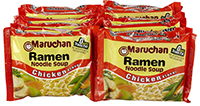 When you buy a small plastic pack of ramen noodles, check out the print that indicates the expiration or best before date. This information only tells you that the food is best consumed on or before this date.
When you buy a small plastic pack of ramen noodles, check out the print that indicates the expiration or best before date. This information only tells you that the food is best consumed on or before this date.
The truth might be that not even the Maruchan (producer) knows the exact expiration date. On their website you can find this: “We recommend that you refer to the “Best By” code on our packages and suggest that our products should be consumed in a timely manner. WHILE RAMEN NOODLES HAVE A VERY LONG SHELF LIFE, certain conditions over time may reduce the soup quality”
Some even go as far as say that they last forever. For one, instant noodles undergo a dehydration process wherein moisture is removed from the food item to prevent growth of microorganisms. Second are the added preservatives. These are chemicals used to make any food item last for a long time.
For the familiar packaged and dehydrated noodles available at most U.S. supermarkets, a package of ramen noodles delivers around 380 calories; of these calories, 131 come from fat, another 223 come from carbohydrates and 31.6 come from protein.
6. Instant coffee, Tea, and Cocoa
 Storing these favorites will definitely keep up the morale. Instant coffee that is vacuum freeze dried will last forever if kept in a dry airtight container.
Storing these favorites will definitely keep up the morale. Instant coffee that is vacuum freeze dried will last forever if kept in a dry airtight container.
7. Baking Soda
 When left sealed will last indefinitely. Store in an airtight container in a cool dry area.
When left sealed will last indefinitely. Store in an airtight container in a cool dry area.
Besides Sodium (52%), baking soda contains almost no nutritional values.
8. Apple Cider Vinegar
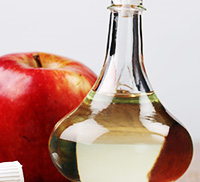 Because of its acid nature, vinegar is self-preserving and does not need refrigeration. White distilled vinegar will remain virtually unchanged over an extended period of time. And, while some changes can be observed in other types of vinegars, such as color changes or the development of a haze or sediment, this is only an aesthetic change. The product can still be used and enjoyed with confidence.
Because of its acid nature, vinegar is self-preserving and does not need refrigeration. White distilled vinegar will remain virtually unchanged over an extended period of time. And, while some changes can be observed in other types of vinegars, such as color changes or the development of a haze or sediment, this is only an aesthetic change. The product can still be used and enjoyed with confidence.
What is “Mother”? “Mother” of vinegar will naturally occur in vinegar products as the result of the vinegar bacteria itself. Mother is actually cellulose (a natural carbohydrate which is the fiber in foods like celery and lettuce) produced by the harmless vinegar bacteria. After opening, you may notice “mother” beginning to form. Vinegar containing “mother” is not harmful or spoiled. Just remove the substance by filtering and continue to enjoy the product.
9. Salt
 Salt is an essential mineral needed by the human body in order to function properly. Salt is here from the beginning of time, and will probably be still good to eat at the end of time.
Salt is an essential mineral needed by the human body in order to function properly. Salt is here from the beginning of time, and will probably be still good to eat at the end of time.
10. Bouillon Cubes
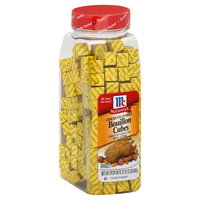 Bouillon is a great prep. I like homemade stock for most things but bouillon is great to have on hand for when you run out or just to throw into soups or stews for a bit of extra flavor.
Bouillon is a great prep. I like homemade stock for most things but bouillon is great to have on hand for when you run out or just to throw into soups or stews for a bit of extra flavor.
Because bouillon has large amounts of salt, it can last a long time.
The only problem for longer term storage is the fact that there are fats and oils in the cubes that can go rancid even with the salt. But vacuum sealing may allow it to outlast you. Rancidification does not occur without oxygen or humidity.
So, how long it stays good after the “best by” date depends on storage conditions only.
Also great to just heat some in water when you have a sore throat or stomach ache.
11. Raw Honey
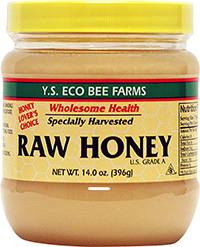 Honey is one food that never spoils! Although the look of your product will change somewhat over time, it will never actually spoil. It will begin to look yellow and cloudy instead of golden and clear and will get thicker and grainy over time, eventually looking white and hard. But, it is still good. In this form, the honey may have started the process of crystallizing.
Honey is one food that never spoils! Although the look of your product will change somewhat over time, it will never actually spoil. It will begin to look yellow and cloudy instead of golden and clear and will get thicker and grainy over time, eventually looking white and hard. But, it is still good. In this form, the honey may have started the process of crystallizing.
To decrystallize honey, place the sealed jar in a warm, non-boiling pot of water and heat the honey. The crystals will dissolve as the honey heats. Do not add water to the honey. This will raise the moisture content and the honey will ferment.
12. Oxygen Free White Rice
 White Rice lasts for 4-5 years but oxygen free white rice will lasts at least 30 years. Brown rice is a whole natural grain with only the hull removed, thus the fats between the remaining layers cause it to spoil more easily than white.
White Rice lasts for 4-5 years but oxygen free white rice will lasts at least 30 years. Brown rice is a whole natural grain with only the hull removed, thus the fats between the remaining layers cause it to spoil more easily than white.
White rice has been found perfectly preserved in Egyptian tombs.
Rice will not store forever, especially brown rice which has more fats and oils than white rice (but is better for you). Brown rice may become oily and give off a rancid odor because of its essential fatty acids that go bad as they oxidize.
One thing to watch for is the presence of the rice weevil, a tiny reddish-brown bug.
13. Soy Sauce
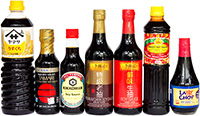 Soy sauce is made of soybeans, wheat, salt and water which are put through a process which brews, ferments, pasteruizes and stabliizes the end product.
Soy sauce is made of soybeans, wheat, salt and water which are put through a process which brews, ferments, pasteruizes and stabliizes the end product.
Even after opening the bottle it is still good to eat for 2-3 years.
14. Sugar
 No matter if white, brown or powdered, sugar it won’t spoil (sugar inhibits microbial growth) as long as it’s stored in an airtight recipient, away from humidity and sunlight.
No matter if white, brown or powdered, sugar it won’t spoil (sugar inhibits microbial growth) as long as it’s stored in an airtight recipient, away from humidity and sunlight.
15. Pure Vanilla Extract
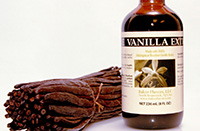 Vanilla extract has an alcohol base so it doesn’t really go bad. You should, however, know that the alcohol will slowly evaporate (when the bottle is open). As the years go by, the flavor of the vanilla extract might become more intense. That’s because there’s less alcohol in the liquid. All in all, if you’ve always kept the bottle of vanilla extract closed, it’ll last decades, so you can freely use that bottle of vanilla extract you’ve bought 20 years ago.
Vanilla extract has an alcohol base so it doesn’t really go bad. You should, however, know that the alcohol will slowly evaporate (when the bottle is open). As the years go by, the flavor of the vanilla extract might become more intense. That’s because there’s less alcohol in the liquid. All in all, if you’ve always kept the bottle of vanilla extract closed, it’ll last decades, so you can freely use that bottle of vanilla extract you’ve bought 20 years ago.
16. Corn syrup
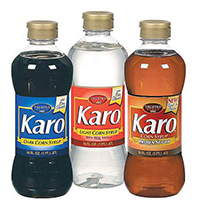 Corn Syrup is safe to eat for an indefinite period of time whether it has been opened or not.
Corn Syrup is safe to eat for an indefinite period of time whether it has been opened or not.
When brushed onto baked ham, barbecued meats, baked vegetables or fresh fruit, it is an ideal glaze. In baked goods, corn syrup holds moisture and maintains freshness longer.
Corn Syrup contains only sugars – which means calories (71%). So 1 ounce of Corn Syrup has 79 calories.
17. Pemmican
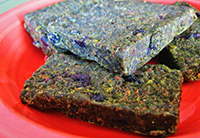 Invented by the natives of North America, pemmican was used by Indian scouts as well as early western explorers. These people spent a great deal of time on the go and depended on having portable, high-energy, highly nutritious, and filling foods that would last for long periods of time.
Invented by the natives of North America, pemmican was used by Indian scouts as well as early western explorers. These people spent a great deal of time on the go and depended on having portable, high-energy, highly nutritious, and filling foods that would last for long periods of time.
Pemmican was light, compact, high in protein, carbohydrates, vitamins, and if done properly can last anywhere from a few years (decades) up to a lifetime without refrigeration!
18. Dry Beans
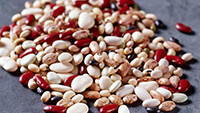 Dried beans can last almost indefinitely in the absence of oxygen and light, but gradual moisture loss will affect taste and texture. Old beans may need longer soaking and cooking times.
Dried beans can last almost indefinitely in the absence of oxygen and light, but gradual moisture loss will affect taste and texture. Old beans may need longer soaking and cooking times.
Dry beans have the highest protein content of any seed crop. They contain all essential amino acids, fiber, starch, minerals and some vitamins.
19. Corn starch
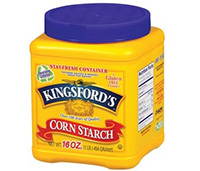 Basically, the only way cornstarch will go bad is if it gets wet.
Basically, the only way cornstarch will go bad is if it gets wet.
You can thicken gravies and sauces for years with just one box of corn starch.
Corn starch contains mainly Carbohydrates (91%) and some proteins and iron. Only one tablespoon contains 30 calories.
Rumor has it… that Twinkies may last for a lifetime despite their official shelf-life (of only a month). But this is NOT true. This has been tested a number of times. They go stale just like other bread products, and have mold after 5 weeks or so, and decay into a pile of mold after a few months. Plus I don’t think they are available anymore in the US (I think only in Canada).
Most canned goods can’t last for a decade. Have you ever opened a tuna can 5 years after expiration date? Not good!
So… What is the 20st Food that can last for over a decade, even half a century?
How to Make Pemmican – The Ultimate Survival Super-Food
What’s the #1 Killer In Any Crisis?
Do You Make These Fatal Mistakes In A Crisis?

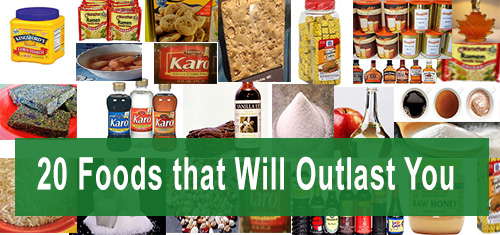















I’ve opened canned soup after ten years. It was fine.
You might be right. I’ve opened a canned soup a year after the expiration date and it was fine. And I’ve just read on some forums … some people said it was fine even 5 years after the expiration date.
But (except some personal experiences) I can find a trustworthy source to back up these claims. Otherwise I would have listed it as no. 20.
A critical issue is how acidic the contents are. Anything in tomato sauce will eat through the inner lining of the can in a few years. Other foods last much longer.
My guidelines:
1. Throw away anything in tomato sauce after its expiration date.
2. Throw if there are any dents at all. They can create hairline fractures in the inner lining, leading to spoilage. I hold the can with one end in each hand and rotate it, feeling for any inconsistencies. Dents near the ends can be hard to see.
3. Look at the ends of the can. They should be concave (very slightly curved in). The slightest bit of outward curve means botulism. The can is hazardous waste and can kill just by breathing the air released when you open it.
I buy canned tomato products like soup, tomato sauce, pizza sauce, and can them in glass jars so I don’t have to worry about them eating through the can. they will last a lot longer also
Where it touches the glass will be fine, but they do have a metal lid, so no guarantee there. I have seen lids that were starting to deteriorate. Just use common sense.
So the 20th food is a stinking advertisement? PS. I will not buy anything from nor listen to one of those long-winded ads. They promise the world and deliver nothing.
No Tex, the 20th food its and “opened question” – meant to share some experience and thoughts. I would like to see how many “long-lasting” foods we can find (with a trustworthy source to back-up the claims).
The advertising has nothing to do with this article. But keep in mind that I only allow a few products on my website. And most of them… I tried myself. For example (this one) last summer I built my first aquaponic system. This spring I’ll probably build a larger one.
No doubt huh C Davis?? Wow Tex, No imagination?? Just that picture alone gave me what I think SHOULD be # 20 on the list…..VEGETABLE SEEDS appropriate for where you plan to be. If you take care first, pack the bucket tight with contents (including both oxygen & moisture absorbers), fill from bottom to top with nitrogen (with the hose you packed your contents around), very well seal the bucket, keep in a cool, dark, & dry location, 1 person could live a good while on this bucket. Thanks C Davis!!!
You do know this site needs support.. Ads are one of the ways it gets support.. Click bait helps to provide all the great content here. You do not have to buy their product.. Heck if your like me you do not have to listen to their pitch.. Open them. Look at it a few of them.. If they drone on turn the volume down and do something else..
All the best
I didn’t even saw that the first time, I figured they forgot 1. It wasn’t until I saw your comment and went back that I saw it. My mind’s default is set up to disregard the ads I guess.
how about ghee – the clarified butter?
Interesting!
But it will go rancid after maybe a year or so without refrigeration.
can last life time without refrigeration unopened
If properly made pure Ghee will never go rancid. It’s another story for Ghee with other ingredients added.
In India they keep Ghee opened at room temperature indefinitely and they have a hot and humid climate.
To use oxygen absorbers with bullion or not when dry canning using vaccum sealer.
dried beans – like rice – can become contaminated by bugs. I recommend vacuum packing.
A quick trip to the freezer for 48 hours will cure the bug problem…
Will the humidity from the freezer not enter the dried product packet and thus cause it to have a shortened shelf life?
If the dried product is vacuum sealed, and has an oxygen absorber and desiccant inside, any moisture should have been taken up by the desiccant. Humidity from the freezer can’t enter a sealed package, whether it be a vacuum sealed plastic bag or a mayonnaise jar.
We have used Diatomaceous Earth (food grade) and our riice and beans were great 10 years later. Packed correctly in the correct containers.
I put up beans in a Mormon cannery “Bishops storehouse” in 1998, In double walled #10 cans with Oxygen Absorbers. They are still good to eat and cooking them slow in a cast iron lodge pot they were soft and had good texture, last week. And just for the record I am not a member of the Mormon church, Even so they have always treated me well when I ask to put up food for my family.
I’m not sure when they stopped letting people can stuff at their facilities. But anyone can still purchase from them. Super nice to deal with. One can or by the pallet
Rice, Beans & Pasta are all good and easy to store for the long run. What types of foods store well and are low carbs for folks with Diabetes who can’t eat rice, beans etc?
1/2 cup of rice, beans and pasta = 5 to 10 carbs ( as a rule). Guess it depends on how heaping your measurement cup is. Most people can have 30 carbs per meal, or even 40 carbs. Don’t know about children.
That is not accurate. Half cup of any of those is well more than 10 carbs, cooked or dry.
For Diabetics (I am one too) might I suggest storing, using and getting used to QUINOA. It is a grain with a VERY low glycemic index, and can take the place of rice, potatoes, pasta, etc. It is extremely high in protein (A COMPLETE protein, by the way), but VERY high fiber, so it would be a good idea to get used to it before TSHTF. There are 3 basic types, categorized by color: Black, red, and white. Black is very strong tasting, white is bland like white rice, but red has a very pleasant, unique flavor. Make sure you soak and rinse it before you cook it. If stored like what, should last 30 plus years.
Chia is also a good source. It lasts a very long time, my experience. VERY HEALTHY.
Quinoa has a higher oil content and will go rancid before other grains will. It will not last 30 years like rice. That said, Quinoa is great for the shorter term. Storing fats are necessary for everyone, but for diabetics, you might want to discuss a ketogenic diet with your doctor (im on this diet), which means your body runs off fat (ketones) instead of glucose/glycogen (carbs). You have to be strict in following the diet or you will get kicked out of ketosis, (natural fat burning mode) because your body will try to eliminate glucose from your blood. Insulin inhibits the processing of ketones, so its a low carb diet (like under 50 grams). If you plan on using this diet for emergency preparedness, fats will be your biggest concern, as they do not store as well. I have found coconut oil (can last indefinitely) and ghee (clarified butter) are the best for this. Some vitamins are fat soluble and you can actually starve to death with a full belly, if you aren’t eating enough fat in your diet. This makes fat storage both a challenge and a necessity for EVERYONE.
They do not recommend the Keto diet for Diabetics due to the high fat content. This is due to the correlation of Diabetes and heart related issues. LOw fat, low carb diets. I know, I am a diabetic. Dr recommends Atkins, high protein, low carb.
I believe Quinoa would become scarce in most places, post-SHTF. It requires a pretty specific climate to grow it. Enjoy it, stock it, rotate carefully. Me, I’m just doing rice.
Quinoa will all but vanish in a big SHTF-it only grows well in certain regions, and as you said, does not have an exceptional shelf life. I don’t keep any that I cannot easily rotate out.
May day bars have all the nutritional needs and 2000 calories per serving and last for years come vacuum sealed also SOS bars
If one has a dietary problem presently, I would suggest that in an end of the world situation, your dietary problem will be finding enough to eat that will maintain your body weight and strength. If you are to survive, your present problem of not enough exercise to offset the sugar-rich diet you are presently eating will be handily solved because you will daily be fetching water, treating the water you have fetched, chopping firewood to treat the water and cook the rice and beans you have squirreled away and if you are rationing so that it lasts you and your family until the field that you have tilled by hand with a pick mattock comes to harvest, your biggest problem will be ignoring that gnawing feeling in your gut from having only eaten 1800 calories that day as opposed to the 3,000 calories per day that you consumed in a prior life.
Your phobias about eating animal products will disappear in a flash as you find that the tofu and other meat substitutes have disappeared and the only food you are able to lay your hands on are mice and rats that seem to have become ubiquitous. Throw in an occasional dog or cat on those days when you are living large, and any food sensitivities that you had in a previous life will have disappeared. Either that will happen, or if you truly have a life threatening allergy to some foods, you will have died, together with the folks who depend on mechanical life support systems or whose life is dependent on a continuous supply of some drug.
Sounds grim, I know, but I think that will be the reality. Your fastidious diet and compulsive cleanliness disorder will disappear in the gritty reality of day to day life.
The problem with that not all problems are so easy to discard in such a way. I have massive diet issues due to an accident. Beans or any gas producing item will cause severe pain. I live on meat and rice for the most part. But I was raised in the mountains. And that’s where I will survive. Will try making Hardtack and Pemmican. And vacuum seal everything as I do that now. There is enough on that list that I can stock pile and live on for a long time.
What about all those places that advertise foods that last for 30 years? Or are we not talking about those?
What about dried pastas?
The foods that are advertised as lasting for 30 years are (1) some of the above commercially sealed in cans or buckets without oxygen and (2) freeze-dried foods. Nearly any food can be freeze-dried, but it costs more than the “naturally long-life” foods detailed in the article above.
Fats cannot be effectively freeze dried and will go rancid. Coconut oil and Ghee (clarified butter) are the way to go for fat storage. Without fat, you can eat all the kale, spinach, etc that you want and you will still starve to death, because you cannot absorb specific vitamins without fats. I own a freeze dryer and they are thousands of dollars (like Harvest Right for example). It is expensive and the store bought products processed this way show that in the price. Oxygen absorbers have to account for all the void air in the container, which will be more in say elbow pasta noodles. Some recommend using dry ice in the bottom, which sublimes to carbon dioxide to help push the O2 out of the product before finally sealing it with O2 absorbers, etc.
Pasta last some years, but will not outlast you, unless you die early.
Pasta will last indefinitely if kept dry and clean(high humidity can cause it to spoil).
When you buy freeze dried food, be sure to check the total calorie count of the packages. Don’t be misled by the number of “days” the food is supposed to last. You need between 2100 and 2500 calories per day if you are not too active. 1200 calories per day is a slow starvation diet. C-rations ran between 3600 – 4000 calories per day depending upon the food mix. That was for young men engaging in combat which is a highly strenuous activity and requires more calories.
(Shelled) Raw sunflower seeds last a long, long time, and are nice because they can be eaten without any prep if necessary, are high in protein, and healthy fats.
Wheat Berries, sealed in oxygen free container.
About #8 Apple Cider Vinegar: “Just remove the substance (Mother) by filtering…” To remove/filter out the Mother is absolute sacrilege! Please do some research on raw apple cider vinegar (check out Braggs). Just shake the bottle to blend and use it.
You are absolutely correct. The “mother” is where the nutrition lies. If you don’t have the “mother” the apple cider vinegar is pretty much useless.
The “mother” in apple cider vinegar means it has not been pasteurized like apple cider vinegar without the mother. It has a very long shelf-life – five years or more.
Yup I keep Braggs also I have used it for many things and with the mother is the best it has helped aching teeth, it can help with lice if caught quick..there was a wart on my sons foot put some of that on a bandaid every night for a week and it turned it black and then was just gone LOVE this stuff!
The 20th food is potatoes.
Can some one tell me how to store milk powder?Is it possible to buy ‘nitrogen?. In what form does it come? And how do you handle it? I would like to put it in a glas jar.( the milk i mean) Please help me !!!!
Nitrogen is the largest constituent of normal air. Packing in nitrogen is usually accomplished by removing oxygen rather than flushing with nitrogen. The usual prepper approach is to add oxygen absorbers and seal absolutely air tight to keep out both oxygen and water vapor. Sealing absolutely air tight means using a Mylar bag within a plastic bucket and heat sealing the Mylar bag.
This process works reliably for grains and similar items which have air spaces throughout. It can fail for compact items like powdered milk and flour., as the oxygen in the center may not get removed. For milk powder, I would recommend either purchasing commercial product intended for long-term storage, or stock rotation of simple untreated boxes..
Dry Ice will also displace oxygen and is sold by my local grocery. BillH is right. I place a 3-finger size piece in the bottom of a blanket storage zip-lock bag (Lowes) then a 50 lb. bag of wheat/corn/rice/beans from a farm feed store. I close the zip-lock almost completely until the dry ice evaporates, completely purging the oxygen with CO2, then I close the zip-lock completely. Place it all in a large plastic storage box for physical protection. Very cost effective. But now that I can see the light at the end of the tunnel, I simply buy Auguson/Walmart 30-year buckets delivered to my home.
Pasta will last indefinitely if kept dry and clean(high humidity can cause it to spoil).
LOL I love this list ty!!! the ending I got a laugh out of the canned soup ….I had a few different cambell’s soups chicken n noodle etc…after about a year or so they molded in the can…the tomato soup has lasted over 2 years so far…and in the US twinkies can be bought again I tried to keep twinkies to see how long they really would last mine never molded etc. but it turned out to be harder them a brick after a few months and it was not coming back even tried to soak water into it hahaha they might be good for weapons if stored right!
You should have tried microwaving them for 30 – 45 seconds and then eating in a hurry. You can also microwave them with a wet paper towel over them to steam them. I am going to have to try Ding Dongs which I like better than Twinkies.
What about Cheez Whiz? I have heard informally that it has a shelf life of 5,000 years. Don’t know who is around to verify that is an accurate figure.
Mustard lasts forever. Food for flavoring things.
How about whole spices not the ground stuff
I suspect we can extend the storage life of almost everything on this list (except for the ones that last forever, like honey!) by storing it in a dry cool storage area. An example: I had a whole lot of seeds in packets, partially used, when we moved. I put the opened packets of the same kind of seeds (like beets, for example) in plastic zip-lock bags with little desiccant packages, the kind that come in vitamins. I put the baggies in a plastic box (not air tight), and kept them in my root cellar. For years, while I built our house. Finally, in 2005, I got to have a garden again. I fished out those ancient seeds (from 1994 and 1995), and thought, Why not try them? The smallest seeds had really poor germination, as expected. The larger seeds, like corn, beets, beans, had almost 100% germination! All but two of the fava beans grew. I couldn’t give them all away.
I wouldn’t recommend this, but it explains to me how really effective keeping things cold can be!
#20 Diatomocues Earth..or DE…Food Grade for human consumption…….to many benefits to list,
google it…. definitely included in my list….
#20 Diatomocues Earth..or DE…Food Grade for human consumption…….to many benefits to list,
google it…. definitely included in my list…
Just a quick follow up …also use DE to mix in with rice beans cereals & grains etc ..will solve the problems of possible infestation from weavils insects etc
This is one of the most helpful sites I’ve had the pleasure of reading in a while…
Thanks everyone !
I am single, but still buy many things in bulk, including 1st grade quality coconut oil. Stored in cool rooam, 70 degrees or ess, it has kept for me for 3 years. I’ve been told its been verified for 5 years. No sign of deterioration when kept cool. For how much lOmger? No one has reported any spoilage. And it is a good all-purpose cooking oil.
Coconut oil usually has a claim of 3 to 5 years, but that is just by the company. Many people say that it can be stored indefinitely. There is a big nutritional difference between extra virgin cold pressed organic coconut oil and the other extraction methods. Just something to be aware of. Coconut oil is also antibiotic, antifungal and antiviral. Too many other benefits to mention. I keep mine in the cool basement, sealed by the manufacturer and in opaque containers. Some manufacturers have clear containers and I avoid that as UV light also causes oxidation.
Great article. Learned a lot. Watching Chernobyl reinforced my resolve not to be reliant on the government in case of disaster. Will put this information to good use in expanding my emergency food supply. all the comments good too. Thank you!
If you look up the Steamboat Bertrand, you will find that some of the 100 year old canned goods that were retrieved when the wreck was found were still perfectly safe to eat. Although Vitamins C and A had been “significantly reduced”, protein and calcium values had not.
These canned goods were, i presume, under water. Not the way most of us keep them.
Under cold water with little temperature variation day to day.
My basement has moisture in it …. but I have high shelves (away from any water on the floor) if I packaged my items in buckets with mylar bags and oxygen absorbers would this be a safe place to store my items … the only other option is the attic which gets wayyyy too hot
V – buckets and mylar bags are not a BAD way to go, however, you will NOT get 30 years out of the goodies. If you can, placing the items in #10 cans and over-do the oxygen absorbers WILL do the trick. Mylar and plastic are semi-permeable – meaning that, over time, outside air can and will migrate into the bags. The cans will also prevent rats and other vermin from attempting entry to your foodstuffs… mylar and plastic is an invitation to them. Good luck!
You may need to add desiccant to control internal moisture. Also use dehumidifiers in your basement and make sure you dont have UV light coming in the windows on your food containers. Air, Moisture and UV can penetrate containers and you must use appropriate plastics to prevent this to a large degree (which mylar bags are laminated with).
tho not actually a food i would say nitrogen all these foode listed as going rancid need to be packed in gas form nitrogen —– put yor dry product in a seal-able (air tight is best) and run a tube to the bottom of container fill container with dry goods .. have other end of tube connected to your nitrogen regulator on your nitrogen bottle open valve (you can nearly seal container if using plastic or Mylar bags as nitrogen displaces o2 it removes the need o2 for bugs and bacteria (such as mold) to grow……
Love the information but a lack of finances make it difficult to do many things. I have some storage and grow a garden from seed for fresh vegetables.
I am now 75 years old but seem to remember when I was a teenager that we could make water safe to drink with halazon tablets, spelling by sound.
I opened a jar of instant (freeze dried) coffee that I have had for years. I only use it when I make coffee frosting. It had mold all over and through it. Never had that happen before.
@Nita: You must have opened it on a high humidity day the last time you used it and left the lid off for a longer period than you usually did in the past. The coffee granules got damp and that allowed the mold to start. You also might have had a little moisture on the spoon you used to dip the coffee out of the jar with. If you want to avoid that in the future put the jar in the oven with the oven on the lower temperature setting possible and let it stay there for about 20 minutes. You can then safely seal it. Live it sealed in the oven until it cools. That will drive any moisture out of the jar. As the air inside cools, it will draw down the lid just a little and seal the jar tighter.
The three biggest enemies of longterm food preservation are oxygen, moisture, and heat/sunlight (and critters – weevils, mice, etc). Remove those elements and most of your foodstuffs – canned/bagged, etc will last much longer than traditional expectations.
We have a sealed tote full of condiments – syrup, mustard, honey, soy sauce, etc – much of which is over years old, that we have been using with no problems.
We likewise store spices/seasoning/bullion, instant coffee, tea, powdered drink mixes, etc. with no problem.
We also have 5+ year old peanut butter that has stored and held up just fine.
Canned hams & spam have kept for us likewise (so far).
Dehydration (fruits, veggies) and sealing in Mylar bags with O2 absorbers has been a good way to go, too.
We also have mylar bags full of beef jerky, instant taters, instant pancake mix, cereals, wheat flour, dried beans & rice, candy bars, etc. Have also mylar bagged a couple cases worth of MRE’s.
We keep all of it in a cool dry place, and (other than one tote that the lid came off of during a move and mice got into), have not lost anything – have been able to eat everything without issue, much of it going back to 2009-2012.
Someone once told me that the boxes of cake/muffin batter will automatically turn toxic over time (even when safely preserved) – can anyone confirm or deny?
Thanks!
Boxes of mix can grow toxic molds if any moisture gets into the mix, but it seems to me that if you made sure the mix was sealed in something like mylar that would lessen the danger. On the other hand, the baking powder in some of those mixes has a finite shelf life that could make the mix turn into a brick. I don’t know if sealing it would help in that case.
There is a food born allergy that old mixes can cause, and it is possibly deadly if not caught. In mixes that are not resealed properly, an unnoticeable mold can grow that can cause sever allergic reactions, the documented ones I’ve seen were from old opened pancake mixes. But they contain a lot of the same ingredients as cake mixes, ect. If I buy mixes, I do it in bulk and repackage them in our normal serving size with absorbers, vacuum sealing, and buckets to keep moisture out. I feel more confident in it’s quality, easy to use since in portions, and rest of stock not put at risk since they are all sealed. Makes it easier for the kids to use too, without accidental spoilage from not getting shut proper and such. Gotta love teenagers and lack of attention to details….like closing something before returning to that all important texting session.
I don’t know about toxic, but I have tried cake mixes that have expired dates of 1-2 years and the resulting cakes did NOT turn out very well. Did NOT eat them. I guess if I want to keep cake mixes I should place them into mylar bags with O2 absorbers.
Even if you pack flour-based mixes with oxygen absorbers, it may not keep. This is because flour is too dense; the oxygen in the center of your container will remain. You can try commercially packed. But I even had some commercially sold pancake mix (in #10 cans) from a reputable survival food manufacturer go bad in about 10 years. So if you really want flour that lasts 30 years, store wheat berries instead and grind it just before you use it.
Oh yeah! anything that has flour in it is not a good candidate for long-term storage. Should be stored with just the wheat berries, and a hand-powered grinder close by.
A mix is one thing (because its dry). Batter that has moisture in it, along with a low oxygen environment, is the ideal environment for Botulism, which is fatal blood borne illness if you dont get the antitoxin immediately. This is the primary concern for food prep done incorrectly, so look this up.
I understand what you mean …..I think you forgot something or did not think know about it.
That is Hardtack….Simple ingredients and easy to make……
Hardtack lasts indefinitely when stored properly and kept dry. It is the vast majority flour. Simple to make…..
Supposedly there is still stored from the so called Civil War that is edible……if one can really say Hardtack is edible…LOL
It s called HARD Tack for a reason….Rumors have said you could use it to pound nails with or use it for a weapon and beat someone to death with it…
To eat it soak it in water for …as long as it takes….and something else to give it some flavor IF you can find such…..Hopefully some Bacon grease that will definitely work perhaps Beef or Chicken or other Bullion…..
Just saying
I would like to share this and it is not a long term survival food but sort of a campfire bread so to speak and that is Bannock.
There are all kinds of recipes for it. From plain to making it as a sweet treat…..Search bannock recipes….
I found and picked a site at random that has Three different recipes…..But there thousands of different recipes for it to discover…..
https://www.northernontario.travel/sunset-country/bannock-recipes-for-your-next-camping-adventure
I hope you like and enjoy! Let me know.
Civil war soldiers would use their rifle butts to grind hardtack on a rock and then mix it with coffee.
The thing to remember about expiration dates, as they relate to canned foods AND medications:
Expiration dates are used to be sure that the general public will throw away any item that is “past its expirations date” and buy new items. This is how the companies make their money.
I’ve used all kinds of products that have expired dates. The product was great.
So keep in mind that the expiration dates are not to protect you from a “bad” product, but are their for the companies to keep making money
Most medications are safe for years past their expiration date, although they may gradually become less effective with time. The exception to the rule is tetracycline; DO NOT use it past the expiration date as it can become toxic.
Aspirin will also go bad but you can tell the minute you open the jar. It smells highly acidic. You can’t miss the odor. It is like sniffing a car battery or a bottle of vinegar. I have heard the odor described as a vinegar order. That means moisture has gotten to the aspirin and changed its chemistry. Do not take vinegary aspirin.
Very nice. Good work!
Seeds, seeds and more seeds is my number one priority past the first few days/weeks. I didn’t know about the long term storage for many of these items listed, so the article has been a wonderful resource for me.
Plus one to the commenter about the tomato in tins. I recently had some two year old tomato soup tins disintegrate, and what came out onto the shelves wasn’t pretty, nor red.
gosh I have learned a lot today reading. I have been prepping for 3 or 4 years, canning and getting store bought foods. I am thinking it may all be in vane. Much of the soft foods I have stored will be no good if TSHTF. The meat I have canned will be no good in a few years?..Maybe I should give a party and give all I have away and get new stock. what a waste.
Not a total waste. Use what you can, donate the rest.
Rotate your stock. Eat the oldest of what you have and replace. All stored items should have the month and year that they were stored on them.
No one mentioned a most essential ingredient that is needed by the body and more important than food.
And the the answer is Potable Water.
Water can and does go bad. The Spaniards would stop and take on river water in the St.Marys River that is the border of Georgia and Florida. The Tannic Acid from the decomposing leaves would preserve the water…….and it would last longer.
Freezing seems to keep H2O fresh! Example Glacier and Polar Ice seem to be sold at Premium Prices…..
Keeping tons and tons of ice is out of the question….
Reverse Osmosis is not cheap……..
So what does one do besides rotate H2O in and out along with other items in their Bug Out Bag or Hurricane Box
The survival “rule of threes” does indeed say that water is more important than food. But your (implied) solution is way insufficient. What you need is an essentially unlimited supply of water, which either is potable, or can be treated to be potable. You need a well or body of water on your property. Or, a way to cart quantities of water from a nearby source. What use is 3 months or a year of food of you only have a few weeks of bottled water? There is no practical way to store months of water.
Yes, you also need some bottled water for use the first few weeks, while you establish your main source.
If you want long-term survival, you need more. Besides drinking, you need water to reconstitute dried or dehydrated food, to wash (else you die from diseases, the most deadly aspect of most major survival situations), keep your garden going during dry perions, and perhaps flush toilets.
The 20th item should have been the 1st item: WATER. Also, Yoder’s canned meats, if stored properly, are listed as having a 25 year shelf life. Storage is the key factor – cool and dry. We are a meat and potatoes family, so a bunker full of canned meat and a root cellar full of garden grown potatoes are our basics. We also can some of the potatoes and store #10 cans of commercially produced potato flakes.
The above comment from “erozon max” should be removed. The link is to an ED advertisement.
The above comment from “erozon max” should be removed. The link is to an ED advertisement.
I have dry canned beans and rice, It takes care of any weevils and any other critters that may be in them! Shelf life around 25-30yrs.
I e been reading many preppier articles from Ask a prpper re entry and have learned so much, thanks y’all for sharing info, my hubby and others think I’m crazy,but I see the time coming a lot sooner then they think, so I’ve started stocking and getting ready. I’ll continue reading all these articles as I continue stocking things and ordering stuff that I’ll need.
Most “disasters” are personal in nature. Unemployment, injury, and illness can happen to anyone, anywhere. Telling people this helps them understand-everyone’s been late on bills at least once.
The problem with that not all problems are so easy to discard in such a way. I have massive diet issues due to an accident. Beans or any gas producing item will cause severe pain. I live on meat and rice for the most part. But I was raised in the mountains. And that’s where I will survive. Will try making Hardtack and Pemmican. And vacuum seal everything as I do that now. There is enough on that list that I can stock pile and live on for a long time.
I am truly delighted to read this webpage posts which consists of
tons of helpful information, thanks for providing these kinds of statistics.
In Korea, ramen companies claim not to use preservatives. For microorganisms to reproduce, water content must be at least 12%. However, noodles and powder soup has a moisture content of 4 to 6%. In this case, there is no need to use preservatives. I have experience eating ramen after 5 years. I remember it wasn’t savory. but there was no inconvenience in eating.
If the current trend continues, nuclear wars are likely to break out on the Korean Peninsula and the Strait of Taiwan. I am worried.
I am worried too. Praying things don’t go nuclear, but it is scary just thinking about it. Stay safe.
We live in south Florida. No basements and no root cellars due to high water tables. Garage gets very hot. Any suggestions for a “cool, dry, storage area”? In the house with AC works, but if the SHTF we won’t have AC.
I love some of the suggestions in here.